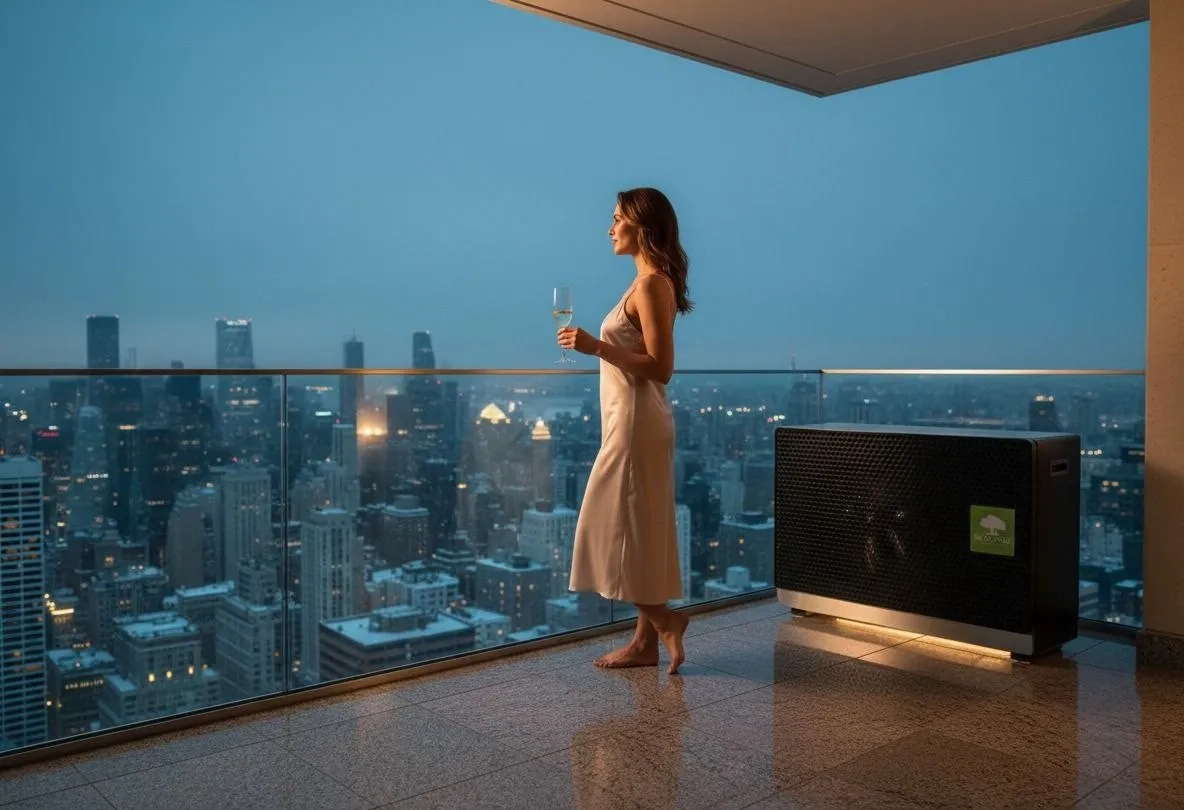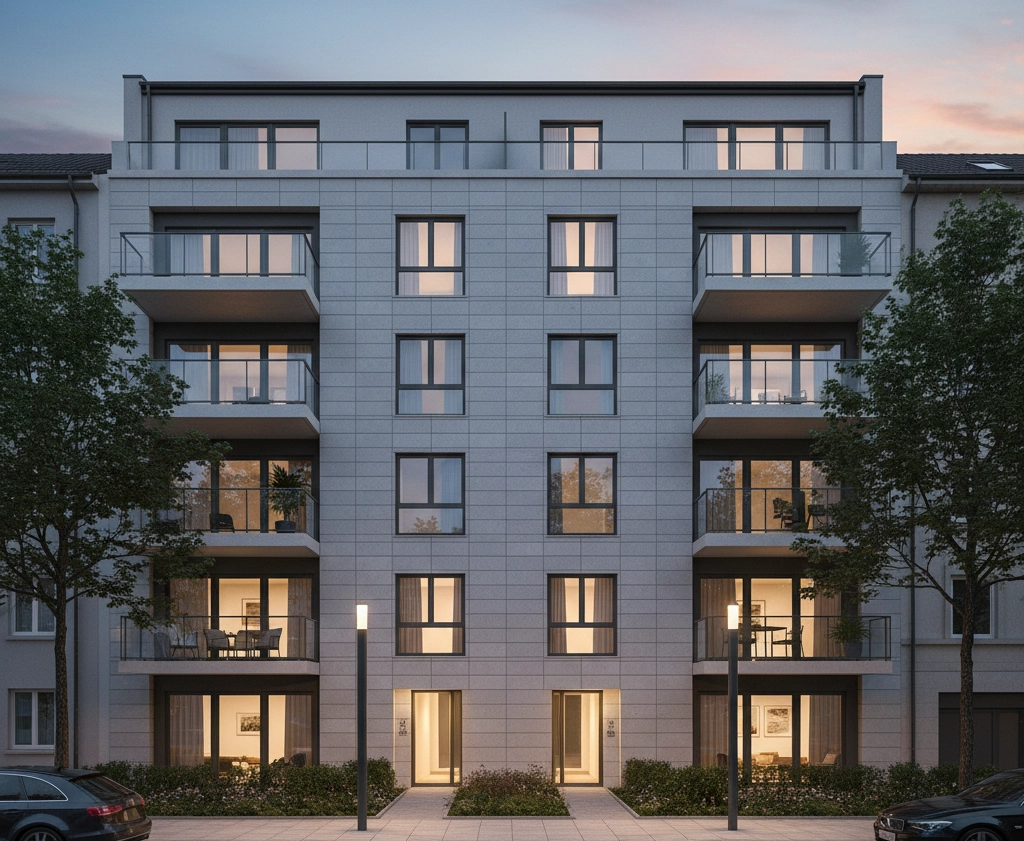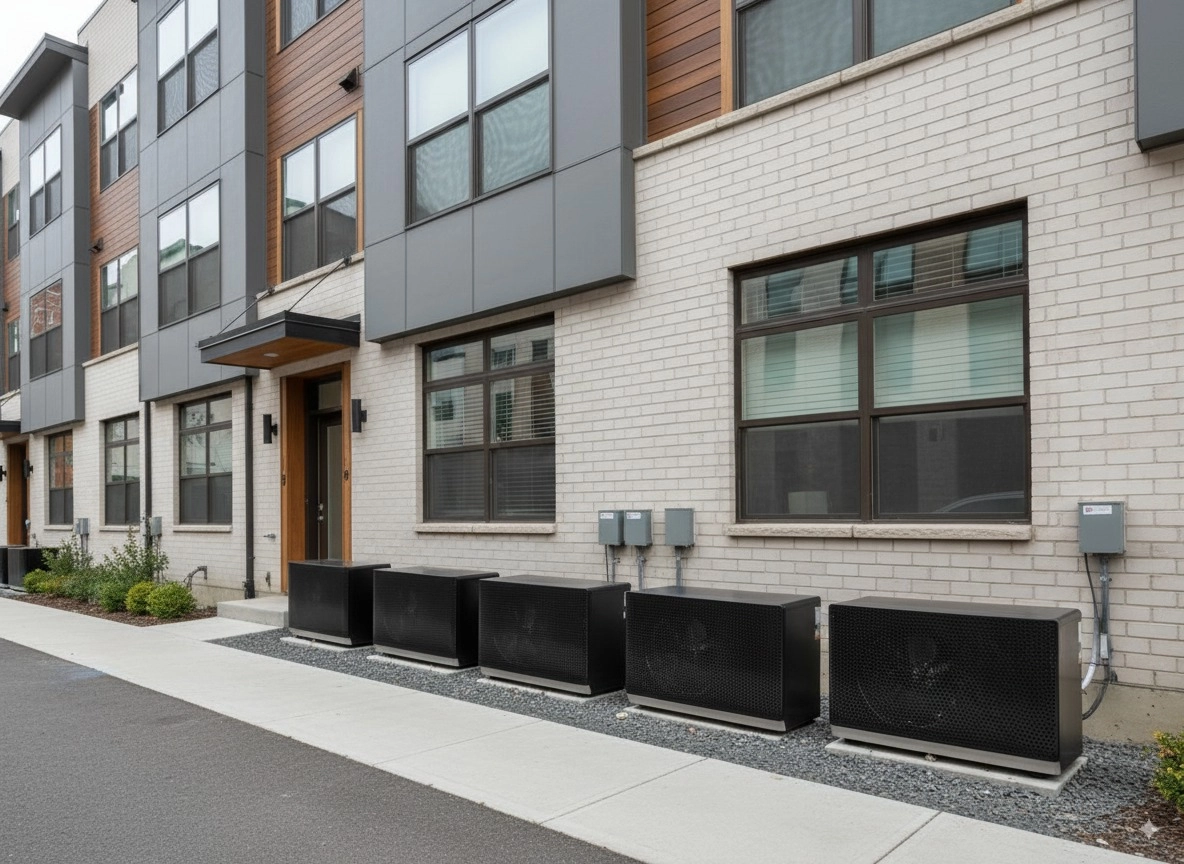
From harsh winters in Stockholm and Warsaw to hot summers in Berlin and Paris, modern apartment owners face the same challenges: high costs for heating in winter and cooling in summer. District heating does not allow temperature control in individual rooms, and air conditioners add extra installation and maintenance costs. As a result, apartment owners overpay for utilities without achieving an optimal indoor climate.

That’s why more and more Europeans are looking for an alternative apartment heating solution that not only reduces utility bills but also ensures year-round comfort. The “heat pump + fan coils” system is becoming the optimal solution for multi-storey buildings from London to Amsterdam, offering both heating and cooling through a single system.
How the BeeSmart + Fan Coils system works
The BeeSmart air-to-water heat pump operates by transferring heat from the outdoor air to the heat transfer medium (water) even at very low temperatures. Unlike traditional systems that burn fuel to generate heat, a heat pump consumes electricity only to move existing heat, making it highly efficient.
The key advantage of fan coils over radiators is their ability to operate efficiently with low-temperature heat carriers (35–45°C instead of 70–90°C for radiators). This allows the heat pump to run with a higher COP (Coefficient of Performance) — the ratio of produced heat to consumed electricity.
Modern inverter BeeSmart heat pumps have a seasonal coefficient of performance (SCOP) from 4.72 to 4.98, which means that for every kilowatt of electricity consumed, the system produces almost 5 kW of heat. This ensures an A+++ energy efficiency class and a significant reduction in apartment heating costs with a heat pump.
How to choose a heat pump and fan coils for an apartment
When choosing a heating and cooling system for an apartment, it’s critical to pay attention to:
- Heat pump capacity — calculated based on area (approximately 100–150 W/m²)
- SCOP — for maximum savings, choose models from 4.5 and above
- Energy efficiency class — ideally A+++
- Operating temperature range — for northern regions, it’s important that the system operates at -25°C
- Compressor type — inverter ensures smooth operation and savings
- Refrigerant — R32 is eco-friendly with a low GWP (global warming potential)
- Fan coil noise level — for bedrooms, below 25 dB is critical

To ensure maximum efficiency and integration with existing systems, pay attention to hybrid operating capability and the presence of quality certificates such as Heat Pump Keymark.
BeeSmart and Silent MCFS fan coil models
The BeeSmart heat pump range includes models of different capacities for apartments from 60 to 180 m²:
| Model | Heating, kW | Cooling, kW | SCOP | Class | Area, m² |
|---|---|---|---|---|---|
| BeeSmart 9 | 9 | 7 | 4.72 | A+++ | 60-80 |
| BeeSmart 12 | 12 | 9 | 4.74 | A+++ | 80-110 |
| BeeSmart 15 | 15 | 12 | 4.98 | A+++ | 110-140 |
| BeeSmart 19 | 18.5 | 15.8 | 4.83 | A+++ | 140-180 |
All models are equipped with Mitsubishi inverter compressors, operate in a temperature range from -25°C to +43°C, have a built-in 6 kW electric heater, and support SmartGrid, Modbus, and weather-compensated control.
Mycond Silent MCFS fan coils complement the system, providing both heating and cooling in each room:
| Model | Heating, kW | Cooling, kW | Noise, dB | Depth, mm | Area, m² |
|---|---|---|---|---|---|
| MCFS-1 | 1.0 | 0.75 | 18.3 | 134 | 10-15 |
| MCFS-2 | 2.5 | 1.5 | 19.5 | 134 | 15-25 |
| MCFS-3 | 4.0 | 2.3 | 20.1 | 134 | 25-35 |
| MCFS-4 | 6.3 | 3.1 | 21.0 | 134 | 35-50 |
Advantages of choosing BeeSmart + Silent MCFS
The combination of the BeeSmart heat pump with Silent MCFS fan coils delivers a number of benefits:
- Utility bill savings of up to 40-60% compared to district heating
- Full microclimate control — precise temperature regulation (±0.5°C) in every room
- Low noise level — only 18.3–21 dB, comparable to rustling leaves
- Heating + cooling 2-in-1 — one system for all seasons
- Independence from centralized systems — no more unexpected shutdowns
- Eco-friendly — R32 refrigerant with a low environmental impact

Comparison with alternatives
BeeSmart vs District heating + air conditioners
BeeSmart advantages: Full temperature control, 40–60% savings on utilities, heating and cooling in a single system, independence from the utility provider.
BeeSmart disadvantages: Higher upfront investment, requires space for the outdoor unit.
BeeSmart vs Gas/electric boiler + split systems
BeeSmart advantages: Lower electricity consumption (COP 4.7+), eco-friendly R32 refrigerant, one outdoor unit instead of several split systems.
BeeSmart disadvantages: More complex installation requiring a hydronic system.
Fan coils vs Radiators
Fan coil advantages: Fast response (under 10 minutes), cooling mode in summer, compact (134 mm depth).
Fan coil disadvantages: Visible on the wall (though the modern designer casing compensates for this).
Hybrid heating scheme
A unique feature of the BeeSmart system is the ability to operate in hybrid mode with existing heat sources:
- BeeSmart operates as the primary source for 80–90% of the heating season
- In peak frosts (below -15°C), a backup source (e.g., district heating) connects automatically
- The "Economy" function automatically selects the most efficient heat source
- Ability to physically shut off district heating for 9 months of the year
This scheme is especially relevant for countries with cold winters, such as Sweden, Poland, or northern regions of Germany, where it is advisable to have a backup system on the coldest days of the year.
Real-world application scenarios
New builds (London, Berlin)
80 m² apartment without district heating: BeeSmart 12 kW + 3 MCFS fan coils to fully cover all heating and cooling needs.
Older stock (Warsaw, Stockholm)
120 m² apartment with cast-iron radiators: BeeSmart 15 kW + 4 fan coils + hybrid scheme connected to the existing heating system for peak loads.
Modernization (Amsterdam, Paris)
65 m² apartment with an autonomous gas boiler: BeeSmart 9 kW + 2 fan coils + gas boiler as backup for the coldest days.
Installation, operation, and service
Installing a heat pump in an apartment requires proper placement of the outdoor unit — on the balcony, insulated facade (with property management approval), or the building roof. The system requires 3–5 kW of electrical capacity (standard single-phase 220 V).
Maintenance is minimal:
- Annual technical inspection of the heat pump
- Replacing fan coil filters every 3–6 months
- Using "Sleep" mode to reduce noise to 18.3 dB and save energy
Frequently asked questions
Can a heat pump be installed in a high-floor apartment?
Yes, the outdoor unit is placed on the balcony, facade, or roof. The key point is coordination with the property management company and compliance with vibration and noise standards.
How many fan coils does an apartment need?
For a 2–3 room apartment (60–80 m²), 2–3 fan coils are sufficient. Optimal guideline: 1 fan coil per 20–30 m² depending on insulation.
Does BeeSmart work at -20°C in winter?
Yes, BeeSmart operates down to -25°C. At the same time, the COP decreases to 2.4–2.7, but the system remains more efficient than an electric boiler. A backup source can be connected during peak frosts.
Comparison table
| Parameter | District heating + air conditioners | BeeSmart + Silent MCFS |
|---|---|---|
| Energy consumption | 100% (baseline) | 40–50% (savings thanks to COP 4.7+) |
| Temperature control | Minimal, depends on the utility provider | Full, accuracy ±0.5°C |
| Room-by-room zoning | Not possible | Yes, individual fan coils |
| Summer cooling | Separate air conditioners | Built into the system |
| Environmental footprint | Boiler plant emissions | R32 (GWP 675) |
| Noise level | Noise from pipes and radiators | 18.3–21 dB |
Step-by-step checklist for choosing a system
- Measure the apartment area and calculate capacity: 100 W/m² for insulated buildings, 150 W/m² for older buildings
- Check placement options for the outdoor unit: balcony, facade, roof
- Assess electrical capacity: 3–5 kW for 9–15 kW heat pumps
- Choose a model with SCOP 4.5+ and A+++ class
- Determine the number of fan coils: 1 per 20–30 m²
- Decide between a standalone and a hybrid system
Sizing formula: Heat pump capacity (kW) = area (m²) × 0.1–0.15 (insulation factor) × 1.2 (reserve). For example, for an 80 m² apartment: 80 × 0.12 × 1.2 = 11.5 kW, so BeeSmart 12 kW will be optimal.
Switch to an autonomous all-season solution
The Mycond BeeSmart system + Silent MCFS fan coils will provide your apartment with year-round comfort with up to 50% savings compared to district heating and separate air conditioners.
- Free engineer consultation
- Capacity calculation tailored to your apartment
- Integration with the existing heating system (hybrid scheme)
Contact us for a detailed audit of your apartment and a customized solution that will work efficiently in any European climate — from freezing Scandinavian winters to hot Central European summers.